On Friday I pressed the publish button on Cont3xt. It whisked its way onto Amazon and the KDP select processes. The text box suggested it might be 72 hours before it was life, in reality it was only about 2 hours, followed by a few hours of links getting sorted across the stores. I was really planning to release it today, but, well, it’s there and live.
I did of course have to mention it in a few tweets, but I am not intending to go overboard. I recorded a new promo video, and played around with some of the card features on YouTube now to provide links. I am just pushing a directors cut version. The version here is a 3 minute promo. The other version is 10 minutes explaining the current state of VR and AR activity in the real industry.
As you can see I am continuing the 0.99 price point. I hope that encourages a few more readers to take a punt and then get immersed in Roisin’s world.
Cont3xt is full of VR, AR and her new Blended Reality kit. It has some new locations and even some martial arts fight scenes. Peril, excitement and adventure, with a load of real World and future technology. Whats not to like?
I hope you give it a download and get to enjoy it as much as everyone else who has read it seems to.
This next stage in the journey has been incredibly interesting and I will share some of that later. For now I just cast the book out there to see whether people will be interested now there is the start of a series 🙂
Monthly Archives: January 2016
Price, value, 0.99 and ego for authors
I originally posted this on Linkedin, but felt I should have it here too. Working out the best place to put things often includes some re-use/re-posting.

Ready to face the World on its own, growing up and leaving the nest.
It has been a steep learning curve, since September 2015, of writing, publishing and selling, this first novel Reconfigure. My initial surprise at managing to write it in a way that came out almost exactly as I had pictured it, was then met with the confusion of how to design, price and share it as a product. Each of the steps in that process I took decisions, some where more clear cut than others.
The price, of my precious creation, was the hardest. I thought that going in too cheap would make the work seem as if it was a throw away piece, published solely for reasons of ego. I thought if it was too expensive, it would of course not reach anyone, and how could I dare charge for something by an unknown writer. That was balanced a little by my own internal hype, that I felt I was not totally unknown. In reality in the sea of internet presences and products, we are all pretty much unknown, unless you count as a global multi-award winning superstar or win the viral lottery and have something to ride that wave with. They were not generally born with that popularity though. We are all just people.
People, many closer to me than not, seem to enjoy Roisin’s story. I have no idea what people from a wider more diverse circle feel about it, yet. I sit and worry about reviews, what if I get lots and they say it’s terrible. Equally I worry about people not reviewing because it is just not worth the bother to review. The book is not me though. Looking at it from it’s perspective, it is happy to be out there ready to be discovered. I have done what I needed to release the story. Now it is the books job to win people over. That way I can park this ego, or personal validation need, for downloads and sales and just try and help it along without it defining me.
That is all a bit deep, and potentially odd to hear. However, having written a second book I find my attitudes to its acceptance as part of the series to be different. I am going to send it out there, and whatever happens, happens. I can engineer serendipity a little, with mentioning its very existence, but I can’t make people want to read, or read it. If they want to they will. I do not have a corporate marketing budget to make it part of every waking moment in everyones lives. That would be horrible though!
Having run the free promotion days and seeing such a big difference in downloads, from the $2.99 book sales, it is clear that $2.99 is too much. That price point was slightly enforced by the structure Amazon sets. If you want to get 70% as a royalty you can only start pricing at $2.99, which becomes £1.99 in the UK, as a minimum rather than an exchange rate difference. As a new author, and doing all the work, my brain thought, “hey, 70% is a decent amount.” The other rate is 35%. For an ebook that seems woefully low. Yes there is storage of the data, the shop front etc., but Amazon are getting 65% at that low rate. My ego, not my business brain, felt that was wrong. So I couldn’t price any lower than $2.99. I think that may have been incorrect, and my heart leading my head. Getting the book out there is about volume, not individual profits. Whilst Amazon may be taking too much, IMHO, that is what they are taking, that is the playing field, the rules of the game. Amazon, of course, don’t actually care as a transport mechanism for my book or anyone’s. They thrive of volume, one product sold lots or lots sold of individual items. So self publishing might cut out a certain part of the middle man process, but it is not generally the creators of anything who gain the most financially.
With this in mind, I just made a chance and hit the button, not to go totally free and never get any financial recognition for the work, but instead to the enticing $0.99 or 99p in the UK and other regions. This may make a difference to volumes downloaded. With a second book, yet to be priced, it may entice two sales? Yes I have written twice as much, but 2 x 0.99 is better than 0 x $2.99 and I want people to just read it.
Will that make any difference? I have no idea. As with all these things there is an element of luck and timing, combined with anything related to the quality and the value of the work. It means I feel much more relaxed about Cont3xt now though. The first book, was as if I was buying a lottery ticket for the very first time. Excitement and nerves, hoping for a massive win. That could happen, and sometimes does, but most things require time and effort, presence and demonstration of ability in the field. I may have a long track record in emerging technology, social media, blogging, a bit of TV presenting etc. That does not entitle me to immediately burst onto the scene and expect critical and financial success.
With that new attitude, I can move forward and explore interesting story lines and ways to share them. The work is there if anyone needs it. It does not require my constant presence, it is a product, hosted and available 24/7. It is still my baby, as is Cont3xt, but they are growing up and leaving home. They still need my support, and they are very welcome of the support from everyone they have had so far too, as am I.
Reconfigure is available on Amazon in all regions as an ebook and paperback. Go and give it a try, and maybe write a review too?
Cont3xt, the follow up is out soon.
Time for WebGL? Quicker virtual worlds in Unity3d
This weekend I helped a friend get a network connected Unity3D environment up and running. I have, of course, done this a lot. In fact it has generally been the focus of most of the dev projects the past 7 years. I guess that means I am past the ‘expert’, know it all, part and into mastery, when everything reminds you of how much you have yet to learn, in the vastness of a subject.
This time though I was faced with the deprecation of the Unity3D web plugin. I had seen the draggle facing out of the incredibly useful and powerful plugin due to the web browser developers taking away support gradually. I have used Unity3D for many years because of its flexibility in allowing me as a developer and creator to have the potential to target lots of running platforms from a single base project. The WebGl option has sat there for a while and I have experimented with the basics of what Unity3D creates. The problem is, when all the core routines are in the plugin, you provide your layer of code to make it do something. The Plugin is a collection of API’s and routines. When you switch to WebGL Unity3D, or any platform, has to provide a lot of the underlying function to support your application as part of the package. Also the plugin would typically have some permissions given to it by the user, that a WebGL page with a stack of javascript tucked away in a compressed file does not have.
Consequently I was not really expecting, without a lot of hacking, for my basic set of tools to work to allow me to create a standard multi user environment, and have it still run without the user having to do very much, other than access a web page. i.e. no install.
Surprisingly is did work though. I use Photon, and its default Worker demo as the basis to test things. When I pushed to WebGL instead of the web player it actually worked. There may be some backing off on which protocol it is using, as it negotiates the best way to talk to the other clients, but it worked without any hassle.
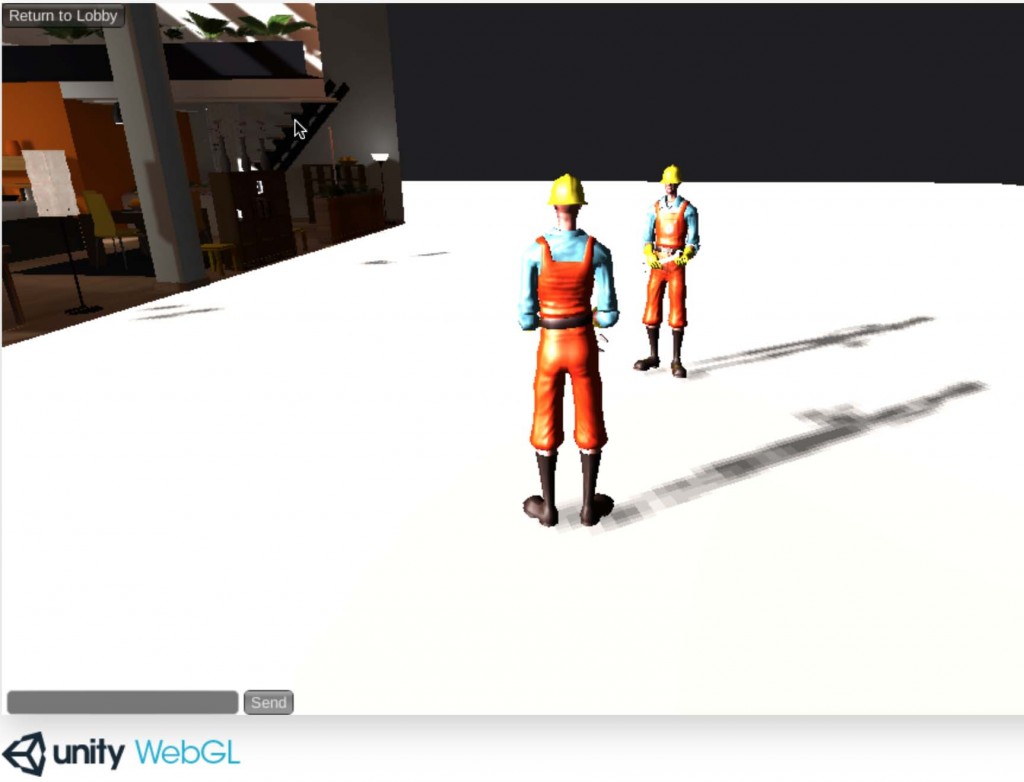
Interestingly it also worked, well nearly, on the iPhone. The Web plugin was never designed to work on any smartphones or tablets, instead you build specific apps for those devices. However, the basic demo actually started and connected on Safari on the Iphone. The problem was that the demo uses the old GUI code and not the fancy new Unity 5.0 user interface. So it has no idea about responding to touch inputs unless you put extra code into it. I may well give that a go to see where this deployment option is going. If it does actually work (despite not being supported) it further eradicates the need to package and build apps. People get the up to date version on serving.
Despite working straight away locally, I had a few more problems when i just placed the WebGL on my 1and1 server. The packaged up versions of all the code, with mine and Unity is stored in a several files a .jsgz, .memgz and .datagz which the unity loader.js wants to pull in. It decompresses them in memory at runtime. However the files were listed a .js, .mem and .data in the index.html. I think the generator looks for uncompressed versions first and then looks of the zipped versions. Somewhere in that I was get an error, but when I changed the generated index.html to look for the compressed files directly it actually worked.
I suffered from some caching problems with the .html file though, that made it seem it was not working. Having changed the internal URL’s and reloaded the page it still failed. Looking at the source I saw it had not changed. A shift/reload used to force a non cache version of the page, but that did not work, neither did closing safari. Renaming index to index2 did the trick. Some of this may be edge of network caching or 1and1, or the browser juts being too much in control. It is an old problem many developer have had over the years as the web has matured.
The good news, then, is that the Photon Unity Network – Free samples, with the Worker scene seem to connect across web browsers in a peer to peer way, just as the old one used to with the plugin, but now in WebGL. I have not tried Unity’s new networking but I assume it will work also. If the packets flow then that means there is some hope for voice, though it is a packet hog and the packages are few and far between to do voice chat.
It actually took longer to get a shared project up and synching than it did to get a custom little virtual world working.
There will be a lot of details that don’t work, how graphics are rendered, lighting etc. The entire, mature Unity3D plugin has to be rebuilt in bits of javascript, which sounds crazy, for each application. However, there are some clever optimisation routines that only provide the bits of the code that are needed, it seems. So everything old is new again and I can get back to making online environments quickly for customers and projects.
Technology, under the veneer
I tend to do the family food shopping, being based at home it is good to get out and head to the supermarket, rather than online deliveries. I usually head to Sainsburys because the local store has self scan as you go around. The handset lets you scan the items as you pack them in the bags in the trolley. You then just pay by handing the scanner over (apart from occasionally getting a full rescan by the till operator to check you are being honest), and pay. A benefit of this is that you entire shop is listed on the screen and the price of the item. It is building the list as you go along and giving an indication of the amount you are spending. As the device is so small it does not contain the entire product range/barcode and price references so it is connected to a local network. Interestingly, though, it does not process the multi-buys and offers until it is handed to the cashier. I think this may be partly a systems decision and partly beneficial as the bill is always less than your handset shows.The network connection becomes apparent when something goes wrong with it. Occasionally you scan an item and the device hangs for a little while. Very occasionally, as happened yesterday it hangs completely and looks like it is not coming back. As I was at the end of my shopping trip and heading to the till, I thought I would wait rather than just hurtling off to customer services. The device shutdown and rebooted. I thought at that point I would loose everything from my 45 minute self scanning and have to do the old fashioned way of taking everything out of the trolley and put it on the conveyor belt again. The screen sparked back into life and this happened.
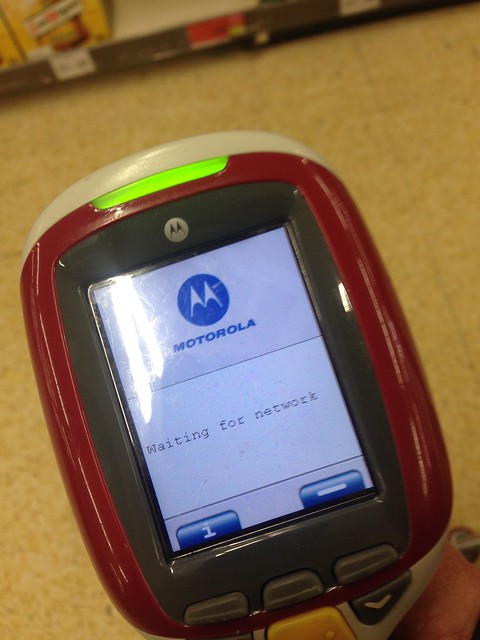
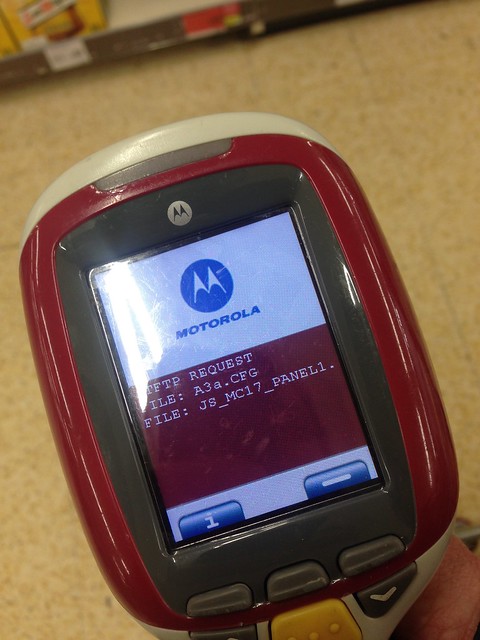
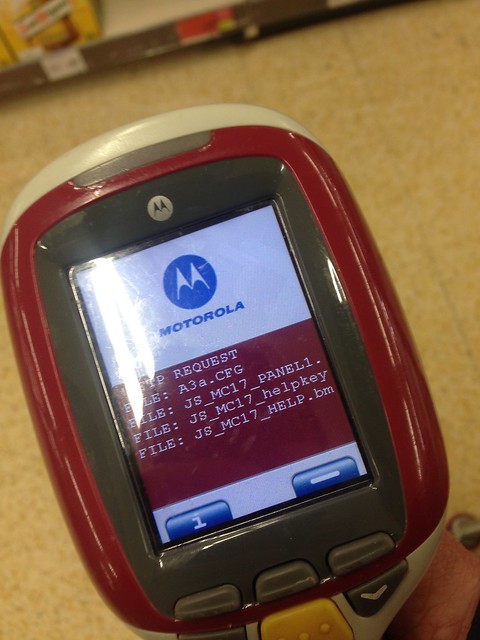
There were a few more screens but it as interesting to see the boot sequence.
Then all the data I had scanned appeared. It was probably only a minute or so, but I was very impressed that the system had a continuous backup, or maybe it is a local cache, of the details. I had to rescan my last two items, as they were the ones it had hung and crashed on, but it worked fine.
Retail is great at mining data and working out who buys what, I assume that they use richer data from the scanners to determine when something is bought. With this constant network connection there is scope for the next generation of these hand held units to deliver more than just the occasional information message.
I can imagine some less tech savvy consumers might be a bit freaked out by the apparently simple little listing device doing all this, and rebooting, which is why it is handy to have some background knowledge of the technology. It made it an interesting little sojourn and break from the current workload. It also showed we are already in an age of IoT, this constantly connected device sorted its own problems out and came back working. Lets hope all the new devices connecting can do the same thing.
Why an IoT book?
The Internet of Things (IoT) is an increasingly popular tag to place on almost everything out in the industry at the moment. It has far surpassed any discussion of Web 2.0 or Internet 3.0. In part it works because it does not have a version number. We all know about ‘The Internet’ as a support structure for the World now. The increase in mobile and app usage has helped separate it from ‘The Web” for many people. We used to, in briefings, have to explain the Internet as the connection of all the devices and the web was an information layer on top. The Web is not the the Internet. I think the average person in the street, bar, front room, office etc would probably think of the Internet as getting a Wi-Fi signal or a 3G/4G set of bars on their smartphone.
It is this social awareness, of connectivity, that lets the term IoT resonate with people. We all have devices that are connected to our WiFi or have some sort of sim card in them, that do not need us to be present for them to operate and communicate. Xbox and PS4 patch themselves over the air, dropbox and iCloud etc. synch their fields all over the place so we always have what we need. These are all simple everyday items already connected to the net and doing their thing. So they are obviously part of the Internet of Things, in common parlance.
That common understanding of connectivity and remote action runs into everyday life and therefore into the everyday life of people in business, CEOs, CIOs and alike combined with new product development and consultants helping shape all of industry.
So, yes, it’s another buzzword to hang everything on, but also, yes it’s really very important to us all. In a recent talk to Predlet 1.0’s year 8 secondary school class I explained to them how important IoT as an idea was to their future. Mainly this is because, aside from a technical career path building things, knowing and appreciated the connectedness of things may generate new industries and businesses that they will work in, or hopefully create.
This pitch was on top of the ‘normal’ discussions of virtual worlds, augmented reality, game technology, 3D printing, brain control devices, and open source attitudes. All those are my bread an butter, but they are also part of the general IoT umbrella of concepts and ideas.
One branch of IoT is that of sensors, instrumenting the World to gain a better insight into what is happening. We have had networked sensors for a while, but they are getting cheaper and more detailed in what they can deal with. This branch smashes into virtual worlds, at least it does where I started with it more publicly in 2006. The World of tennis was being instrumented by Hawkeye. The physical position of the ball was/is captured, via cameras and converted to x,y,z positional data. I used that data to re-visualize the ball tracking in Second Life, in a virtual world. That encompassed a visual representation of an Internet of Things style sensor reading of the physical World. That of course is a one way interaction, but allows many people to immerse themselves in the data at the same time online in a shared space. Tracking those people to help understand what they were watching and doing generated a heat map of activity. That is because it is easy in a virtual world to instrument everything. Avatars and objects re being rendered in a space that has to know where they are in x,y,z space, hence it can be collected and reported on. Making virtual worlds and ideal place to try out large scale instrumentation. What if… there were sensors on this, and there were 1,000 of them dotted around a town, how about 10,000? Oh look something is moving, follow it etc.
Whilst on virtual worlds, one of the first projects that arrived on Hursley island in 2006 in Second Life, was an angle poise lamp. To many people it seemed just like a fancy model, but the guys had wired in the distal lamp to the external World. The lamp was connected by the now open source MQTT protcol. A real lamp in the real lab could be turned on and off with an MQTT message that the lamp was subscribed to. The digital version subscribed to the same message so was in synch with the real world. The virtual bulb lit up when the message was sent. This was also built 2-way though, if you hit the virtual switch it also sent the message, just as the previous web page had. We used it as an example of integration and of pub/sub messaging but also to help people understand the environments are not stand alone, or they don’t have to be.
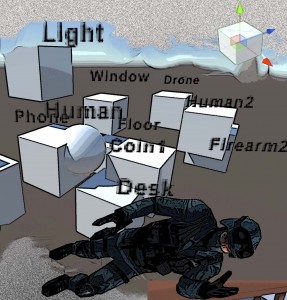
Roisin’s view of the World mocked up during storyboarding the novel.
This detail, about instrumentation and altering the World or knowing what is going on is why I had to label my Sci-fi novel Reconfigure, and the follow up Cont3xt as IoT books in Amazon. Currently if you search for “IoT Books” Reconfigure appears in the top ten of books on the subject. I am not jumping on a bandwagon as such, in the book the World is instrumented and Roisin controls and understands it with an virtual/augment interface. Whilst part of the extension into Sci-fi is made up, the grounding is in a long history of having been ardour this stuff and the experience that brings.
BTW don’t forget, a kindle book does not need a kindle to read it. Amazon has a set of apps and readers for most platforms. So if you want to see IoT in the future, check it out.
Memory and depth of experience is a fascinating thing
I like to explore how things, usually tech related, end up feeling. The human experience is a central one that often gets ignored in any apparent automation or solving of a problem with tech. Products that we all get to use on a regular basis, or trends we buy into are obviously engineered into the user experiences and adverts and branding appeal to a sense of belonging too. Memory though, and how ‘into’ something you can be at any point in time is fascinating.
Many of us have had a few weeks away from training in Choi Kwang Do, classes are starting again this week. Four years ago, this month, predlet 2.0 and I knew nothing about it

Constant practice, and constant learning maintain the philosophy, the physical flexibility and the combinations of movements in our brains and bodies. We are all aiming for it to be something we don’t have to remember, just something we do. The form and shapes are built to remember though. They have start and end points that match, making it suitable chunk for memory to deal with. It knows where it is going. Different belts layer upon the foundation, but the circular nature of memory and practice continues until it starts to become automatic. Though we all know we can always improve and there is always more to learn. It is still in there, ready for instant recall. I know I draw a blank sometimes in practice, when the subconscious and conscious get all mixed up with one another. The importance he is structure and pattern, and where it then goes awry with other types of activity.
Today I was back into my role as a writer/author/publisher/publicist for the first time for a few weeks. The holidays I had pretty much shutdown mentally on the subject. I was still very much following tech, seeing what was going on in the World, but my own self made World was on hold. Maybe there was the odd tweet or response to a reader, but in general I wanted to experiment with walking away from it for a few weeks.
My return needed a kickstart, that has been one that for the next few hours (until about 9am UK Wednesday 6th Jan 2016) of having Reconfigure available for free download. The Uk version is here US version is here
I had to do this to patch back in the feelings of urgency I had for people to read this story. It was still selling over christmas, even copies on xmas day which is humbling. It is still being read on the free library that Amazon runs to Kindle Unlimited. I needed to feel, and be abel to share what was going on and be back in the moment with it though. Obviously I hope I get more readers and reviews too.
This was also to cause a cascade kick start to editing the book I finished just before the holiday. To then start re-reading and editing Cont3xt, the follow up.
Now this is where it got a bit weird. As I started to read it again, I felt like I was returning home, filled with the buzz of the first book. I also though had not spent as much time going over the words as I had with the first one. So in many ways I had just written it and then forgot it.
In forgetting it, I was actually able to enchant and surprise myself at things I had created. I started to think if I had actually written the words. Obviously I did, but in such a state of Flow my conscious mind had not really taken it all in. It must have been there a little. Having read the first 1/3 of the book I remember the story board I did. However, my characters have said and done things that almost seem autonomous. That is a bizarre feeling.
Or at least is was until I related it to code. All my fellow techies out there will have felt the same. Even with code comments, returning to an intricate piece of code after a time away from it, maybe witting something else completely different, there is a sense of ‘did I write that?’ It can be dread at how bad it is, or elation at how clever or elegant it is. Code of course is built from some design or architecture, though that may be a mental model lost into the depths of the brain on the individual who did it. Code is an expression of that, but equally its an abstraction. You can exercise the code and read the code, plus look at the comments. So there are multiple ways to patch it back into your brain.
With a book its a bit different. You have to fund the emotions you felt, the tricks you were playing, with twists and turns, pretty much through the text itself. The storyboard certainly helps, but it seems a good test of the story if you can surprise yourself.
I had seen some writing help suggestions to metaphorically put the book in a drawer and leave it, before going back to it. It is an approach I think I can recommend. Whilst it has been a bit strange, I have gone back to something I like. That could of course go horribly wrong the other way or I am just delusional. Still I don’t have time for that sort of imposter syndrome problem that we all get.
Happy 2016 – The Future is here – Just Cause 3
We have arrived at 2016, it seems only yesterday that it was the turn of the millennium. 2000AD used to seem like the far flung future when I was about 10 years old. 1977 sat in a cinema watching the Star Wars universe explode on screen. As someone who lives and works on future and emerging technologies and trends the new year is always a time to take stock and see where the World is going. In 2015, after a few contracts and good paying work disappeared I was faced with a rather bleak future and no pipeline. It seems that every project, however clever, interesting or potentially lucrative that I have worked on in the past few years have all reached some sort of impasse. Rather than dwell on that our Family holiday in August gave me a flash of inspiration to try something a little different. Many of you who read this blog, or follow me on Twitter and Facebook will have been deluged with the results of that inspiration. That was of course writing and publishing Reconfigure. This near future science fiction is of course an adventure in ideas and concepts, but it is based on a lot of real tech and the real trajectory that it can take. It is also based in how it feels, the short comings of the tech experience, the human errors we make and the fragility of human experience. A struggle to stay on the right path. Roisin also uses a lot of game brain to solve things with a bit of flare and style. I have been reminded of her spirit this holiday by playing my xmas gift Just Cause 3. This is a prime example of free roam fun. You can explore so many ways to deal with situations, or you can just float around enjoying the amazing terrain.
The main character Rico, is dealing with a tyrant and having to pick away at the various bases, gaining them back under his control. Jets, helicopters, parachutes, wing suits, boats, guns, grenades, and the all important tether that he can fire to pull things around, all feature.

As I play it, it has can be frantic and tense at key moments, but it can also be relaxing and just virtual tourism really. Ascending a mountain monastery just to wing suit down the mountain, because you can is as much a part of it as the scripted missions. There is a world, but you can do anything, within certain limits. It is my enjoyment of this style of game that has led to even trying to write a book. There are no rules, apart from the rules that need to be set to make it make sense. Those rules are there to be subverted by some interesting twists and actions.
The book has yet to solve my problem of not having any serious pieces of work bringing in any money yet, and it may never do that, but it is there, very real and something I am very proud of. It has generated a spark of inspiration for me, a rejuvenation and belief in what can be achieved. That spark ignited into the writing of the follow up Cont3xt which is due very shortly out there. I have pushed even deeper in the the real technology of virtual and augmented reality but taken it further, but in a way that makes sense. So these books, and another one after that will act as my prediction for the future. Whether they provide anything else for my personal future I will just have to leave to luck, advertising and good friends sharing their existence.
So personally I have gone from a pretty depressing state of affairs, not seeing a future, to trying to create one for everyone else to immerse and enjoy. It has been a whirlwind and I will keep on riding this one. I will of course stay on the look out for some more ‘normal’ ways to make a living. It all adds to the richness of the experience though.
I wish everyone a happy, productive, fun and futuristic 2016. If in doubt just wing it, with style 🙂
